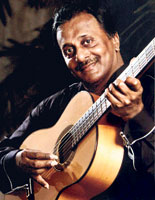
World renowned guitarist Bob Brozman travelled to Papua New Guinea – one of the last places on the planet to have guitars arrive from afar – to capture a sound largely untainted by outside influences; a raw, unique sound developed in isolation. The energetic and distinctive blend of voice and instrument performed by the Rabaul community’s local stringbands reflects their unfailing optimism in the face of adversity, be it war or the volcanic eruptions that have destroyed the town twice in one century, making this album truly ‘Songs Of The Volcano’.
In addition to this extraordinary album, this package features a full length, behind the scenes DVD documentary of the making of the album.
One of the few accidental, yet beneficial, side-effects of colonialism has been guitars washing up on shores all over the world. Papua New Guinea is no exception. Home to a huge indigenous population speaking more than 800 languages, it lay largely undiscovered until the late nineteenth and early twentieth centuries and hence is one of the last places on the planet to have guitars arrive from afar.
Rabaul, in Papua New Guinea’s far flung province of East New Britain, is a town which has had its share of hard times. In the same century it has been destroyed twice by massive volcanic cataclysms and once by a devastating war imposed on it by outsiders. The Tolai people of Rabaul have suffered greatly from these natural and manmade disasters and yet, somehow, have always managed to bounce back and keep their spirits high. One of the main contributing factors to their capacity for optimism is their music, an energetic and unique blend of voices and instruments performed by the community’s local stringbands.
Bob Brozman is a world expert and leading exponent of the National guitar. An ethnomusicologist fascinated by the global voyage taken by the guitar over the last 500 years, he has collaborated with local musicians all over the world.
To create Songs Of The Volcano, in his capacity as Adjunct Professor of Music at Sydney’s Macquarie University, Bob went with filmmaker Phil Donnison to five villages in East New Britain to perform with five different Tolai stringbands. The purpose of filming and recording the performances was partly to document this fragile music before it disappears, and partly to facilitate the musicians in Papua New Guinea where there is an astonishing lack of musical infrastructure.
Rabaul is the location where guitars first arrived in Papua New Guinea, and the music carries a fragile innocence and beauty reminiscent of what guitar music may have sounded like in Hawaii in 1860, or Mexico in 1830. Most music travelled throughout the Pacific Ocean on boats, with sailors leaving behind instruments and ideas to then percolate in isolation. Hence, the music on this album will seem at once exotic, yet somehow familiar. Even today, there is still very little mass media penetration in Papua New Guinea, though that is changing and makes the preservation of this raw and unique sound more necessary.
This album and accompanying film present the story of this creative collaboration, a joint effort between an indomitable group of island musicians and one of the world’s greatest guitarists. Unlike Bob’s other world music collaborations, where there is a blend of styles between Bob and another established artist, Songs Of The Volcano has Bob in a more supportive role, playing simply as a member of each band in their own style.
The creation of this project not only yielded some great friendships, an unforgettable story and some remarkable results, but will enable the musicians to continue their pursuit of a musical life.
The musicians on Songs Of The Volcano are the first recipients of instruments, strings and musical supplies from Bob’s ongoing Global Music Aid Foundation, which seeks to provide donated instruments and materials to musicians in developing countries.
source
Volcano
don't blame this ass
for using a pass
and if it is thegoodone
just say, it will be done










































